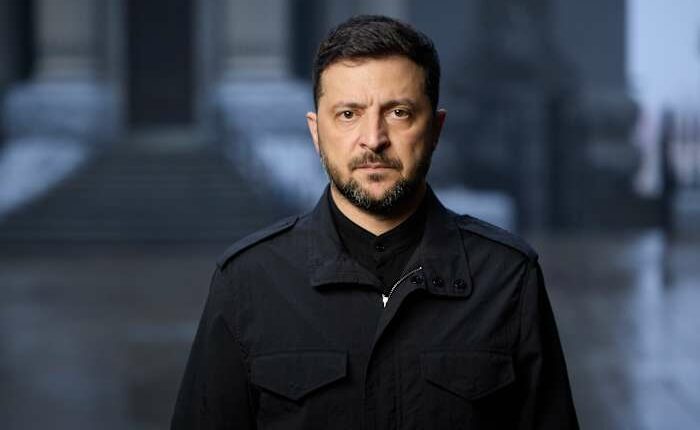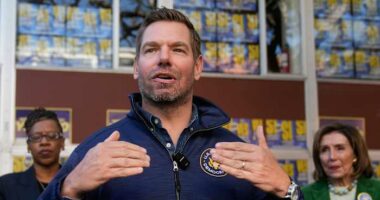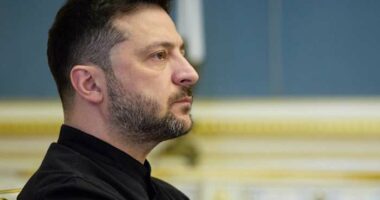Share this @internewscast.com

KYIV – A new American initiative aimed at resolving the conflict in Ukraine places the country in a challenging diplomatic situation. Ukraine must balance maintaining strong ties with its key ally, the United States, while resisting pressure from Russia, which initiated a large-scale invasion nearly four years ago.
The peace proposal consists of 28 points and was developed by the Trump administration in collaboration with the Kremlin, notably excluding Ukraine from the discussions. The plan concedes to several Russian demands, which Ukrainian President Volodymyr Zelenskyy has repeatedly opposed, including the surrender of significant territories.
Russian President Vladimir Putin expressed his approval of the proposal on Friday, suggesting it “could serve as a foundation for a comprehensive peace agreement” if the U.S. manages to persuade Ukraine and its European partners to accept it.
In his nightly address on Thursday, Zelenskyy adopted a diplomatic approach, emphasizing the need for a peace agreement that prevents further Russian aggression. He reaffirmed his commitment to collaborating with both the European Union and the United States.
This article examines the main aspects of the proposal and provides context for better understanding.
Territorial concessions
THE PROPOSAL: The plan says it will confirm Ukrainian sovereignty while also stating that Crimea and the Luhansk and Donetsk regions will be recognized as de facto Russian land, including by the United States. According to the proposal, the borders of the other two regions Russia has partially occupied and claimed as its own — Kherson and Zaporizhzhia — will be frozen along the front line.
Because Russia does not control all of Luhansk and Donetsk, the plan would, in effect, see Ukraine withdraw from areas Russia has not been able to claim in the fighting. This withdrawal zone would be considered a neutral demilitarized buffer zone, internationally recognized as belonging to Russia.
The proposal also says Russia would relinquish other territories it controls outside the five regions, which could include the northeast Sumy region, where Russian forces have crossed the border, and areas around the eastern Kharkiv region that border Russia, although the details are unclear.
THE CONTEXT: Zelenskyy has repeatedly stated that Ukraine will never recognize the occupied territories as part of Russia.
For Ukrainians, the main issue with the plan lies in its contradictions, said Oleksandr Merezhko, head of Ukraine’s foreign affairs parliamentary committee. It starts by guaranteeing Ukraine’s sovereignty but then lists several points that would inhibit or violate that sovereignty, he said.
The plan “is definitely a nonstarter, but I don’t rule out that it might be part of Trump’s game,” Merezhko said. “He starts with something absolutely absurd, ludicrous, which causes shock, and then he becomes more reasonable.”
Security guarantees
THE PROPOSAL: The plan says Ukraine must enshrine in its constitution a commitment not to join NATO and that NATO must adopt a provision that Ukraine will not be admitted in the future. The size of the Ukrainian army would be limited to 600,000 soldiers, and NATO forces would be prohibited from being stationed in Ukraine, a measure that would curtail Kyiv’s right to choose who it cooperates with militarily.
The plan addresses Ukraine’s hopes for membership in the European Union by saying Kyiv should receive short-term preferential access to the European market while it seeks to implement reforms to reach the standards needed for EU membership, including dealing with corruption.
The plan also alludes to security guarantees from Ukraine’s Western allies but without going into detail. It is unclear how the U.S. would ensure Russia does not invade again.
THE CONTEXT: Zelenskyy has continually made the case that NATO membership would be the cheapest way to guarantee Ukraine’s future security. Since he took office, President Trump has made it clear that NATO membership is now off the table.
NATO’s 32 member countries said last year that Ukraine is on an “irreversible” path to membership. But some NATO members, led by the U.S., have balked at moving forward with Ukraine while the war rages and before the country’s borders are clearly demarcated.
NATO expansion
THE PROPOSAL: The plan states that Russia will not invade neighboring countries, and that NATO, the world’s biggest military alliance, will not expand further.
THE CONTEXT: NATO’s decisions are made by consensus, and there is no majority voting. The United States is by far NATO’s biggest and most influential member. Washington has traditionally driven the agenda but has stepped back under Trump. The alliance is the one international forum where the U.S. agrees to put its military might up for negotiation and can be persuaded to act differently by its allies.
Accountability for Russian actions
THE PROPOSAL: The plan also asks Ukraine to relinquish any claims to hold Russia accountable for its actions in Ukraine.
THE CONTEXT: This would deny thousands of Ukrainians any chance to seek reparations or legal vindication of their suffering. U.N.-backed human rights experts have said Russia’s torture of Ukrainian civilians and prisoners of war is a crime against humanity.
Ukrainian political analyst Volodymyr Fesenko said signing the plan would be “catastrophic” for Zelenskyy.
“But the problem is, we can’t say no to Trump because there will fierce pressure from the White House,” he said.
He also said some parts of the plan, such as Ukraine declaring itself a neutral country or giving the Russian language an official status, would require changes to Ukraine’s constitution. Those steps could only be taken through parliament and not by Zelenskyy.
“Ukraine could offer to hold a referendum on these issues — that’s a compromise,” Fesenko said.
Russia’s frozen assets
THE PROPOSAL: The plan calls for Moscow to agree that $100 billion of its frozen assets would be invested in rebuilding Ukraine.
THE CONTEXT: Russian officials have bristled at the idea of using frozen assets to help Ukraine. Kremlin spokesman Dmitry Peskov said last month that “if someone wants to steal our property, our assets, misappropriate them, and take advantage of the dividends from these assets, then, of course, those involved in this in one way or another will be prosecuted. They will all be held accountable.”
___
Associated Press Writer Dasha Litvinova in Tallin, Estonia, contributed to this report.
Copyright 2025 The Associated Press. All rights reserved. This material may not be published, broadcast, rewritten or redistributed without permission.












